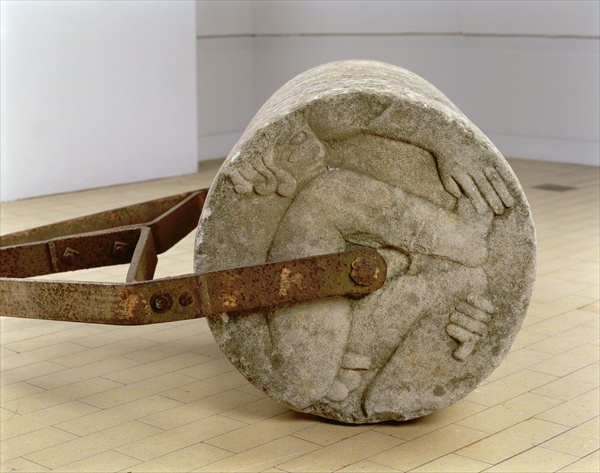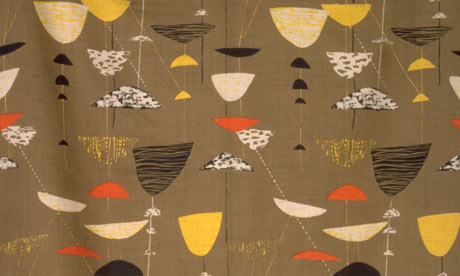I was down in London at the weekend, and took the opportunity to go to the National Portrait to see the exhibition about the legacy of William Morris, called Anarchy and Beauty.
It sounded pretty exciiting - Morris textiles, Pre-Raphaelite paintings and designs, all the way through to Bernard Leach pottery, Eric Gill sculpture and Lucienne Day textiles. Wow! There's a tempting mixture.
I couldn't wait.... so I paid my £14 and in I went. £14!! Never mind, it was bound to be worth it.
It's a teeny tiny exhibition, full of people. People crowded round the jam-packed exhibits in cases with their explanatory labels, so it's difficult to get in to read them. But the gist is that visionary Victorian artist, writer and designer Morris was down with the people, and that his group of like-minded chums were all socialists/bohemians/Marxists/Communists/rebels./radicals Because artists do tend to be, on the whole, socialists/bohemians/Marxists/Communists/rebels/radicals.
Anyway, whilst it was quite a narrow exhibition space, it was strangely difficult to get close to the exhibits to actually see them, and to be honest, I got tired of queueing to try and get close to read them.
There was a Bernard Leach pot, and a little 2-minute video about him, which was moderately entertaining in a general between-programmes potters-wheel way. But it didn't say anything particularly about Leach's specific technique or style. You certainly got no inkling of his whole Japanese vibe.
I've seen a far better and more informative film
at his studio in St Ives (which was manned, incidentally, by a very rude
young besom, who threw my Scottish money back at me at the door, snapping "It
ain't got the Queen's 'ead on it.").
To the left of the Leach exhibit is the highlight of the show. Eric Gill's garden roller. Yes, really.
Eric Gill, Adam and Eve Garden Roller (1933, Portland stone and iron)
Sans-serif sculpting sex-pest, Gill invented the Gill font (unsuprisingly), sculpted the art deco figures on the Midland Hotel and Broadcasting House
Eric Gill, Ariel between Wisdom and Gaiety
and generally set about forcing himself on anyone, and anything, that ventured in his priapic path. Not even the family dog was safe. However, no worries! Because he's now cast as 'eccentric bohemian' rather than 'Savile-like monster'.
Anyway, this is all summed up in the garden roller of Portland stone that he used on his tennis court (there's a socialist in action for you). The ends of the roller are decorated with a typically flambouyant figure of the naked Adam, ready for a bit of roll-on-the-hay action. Presumably an exhausted and fed-up Eve is on the other side, but I couldn't see that, nor was there a photo, or even a mirror so you could see it.
As I said, this is a small exhibition, which all feels a bit crammed in, so when I came to the exciting stuff - the Leach and the Gill - there was only one example, so nothing really to get your teeth into.
Similarly, right along from the roller was Lucienne Day. Lucienne Day! Designer of some of the most fab 50s textiles ever created!! Here was a length of Calyx - but a reprinted length, by the Glasgow School of Art Advanced Textiles Department, rather than an original piece.
Now, when the textile department started the reprinting project, I went up to see an exhibition in the Art School Museum of the fabrics and Day's original artwork for designs such as Spectators and Magnetic.
It was utterly fascinating. They were created out of cut pieces of paper, stuck on to large boards. You could see the hands-on rawness of the designs, the mind in action, thinking out, and indeed cutting out, these hugely influential, Festival-of-Britain zeitgeist pieces of design. They were like little teeny tiny Matisse cut-outs, which were of course being produced at the same time (1950s).
Any of that Lucienne contextual preparatory work here? Nope. Just half a curtain.
And...well, that was basically it.
Now there was a lot in there. A lot in a small space, But, conversely, not much at all. It was like a sandwich tin of amuse-bouche, but no substance. And not worth £14. After seeing the exhibition I have no idea how, in terms of the argument and context of this show, Eric Gill related to William Morris or Lucienne Day or Bernard Leech.
It was like a blunderbuss filled with marshmallows and fired against a wall. Sorry...
Any & Beauty Exhibition Supporters Group.
Take a look at the National Portrait website exhibition link to Anarchy and Beauty .




































